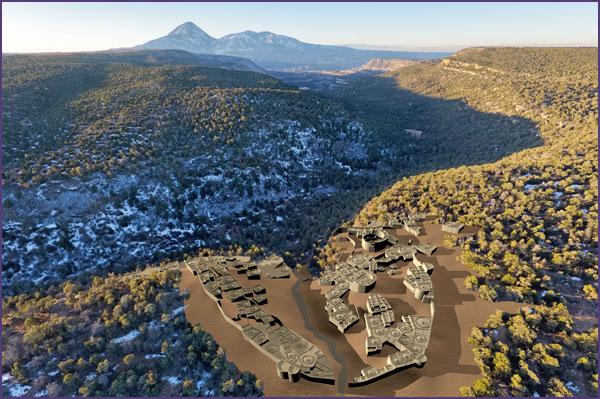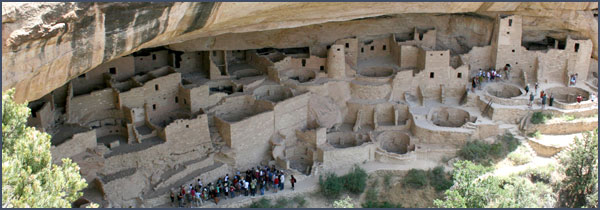Peoples of the Mesa Verde Region
The Pueblo III Period: A.D. 1150 to 1300Housing
The small upland farmsteads that were home to most families early in the Pueblo III period consisted of a masonry roomblock, a plaza area, a kiva, and a midden, usually aligned on a north-south axis. Roomblocks were very substantial in their construction, consisting of masonry walls that were two stones wide. Kivas were generally similar to those of the Pueblo II period, except both their upper and lower walls were consistently built of masonry. In addition, the bench along the south wall was much wider than the other benches; archaeologists call this wide bench a "southern recess." 
Map of early Pueblo III farmstead (schematic). With the formation of large villages later in the period—some of which housed hundreds of people—the basic elements of the farmstead were preserved, but they looked very different when incorporated into a densely populated settlement. Large villages contained many roomblocks and kivas, and the arrangement of structures had to be tailored to the specific setting—canyon head, canyon slope, or rock alcove. Villages wrapped around the heads of canyons or located on canyon slopes often were enclosed by thick walls. Such walls clearly defined the village limits and may have been used for defense. Typically, each village had at least one natural spring that provided a reliable source of drinking water. Controlling access to such a water supply was probably a priority for village residents, especially in a time of drought. At least portions of most roomblocks in canyon-head sites were multistory, and circular, masonry towers were often constructed as well. Towers were sometimes connected to kivas by means of underground tunnels. An excellent example of a late Pueblo III canyon-head village is Sand Canyon Pueblo, located in the Canyons of the Ancients National Monument. The site was partly excavated by the Crow Canyon Archaeological Center, and a report describing the research results appears on this Web site. 
Three-dimensional reconstruction of Sand Canyon Pueblo, a late Pueblo III village, superimposed on the actual landscape (reconstruction by Dennis R. Holloway, Architect; aerial photo by Adriel Heisey). But the people of the Pueblo III period are probably best known for the spectacular cliff dwellings they constructed in natural rock alcoves carved into steep canyon walls. Masonry kivas and densely packed, multistory rooms fill these natural alcoves, which, by their very locations, would have offered a measure of protection from both the elements and intruders. These villages, too, were usually located near springs. Some of the best examples of Pueblo III cliff dwellings are found at Mesa Verde National Park, in the heart of the Mesa Verde region. 
Cliff Palace, Mesa Verde National Park. |
|
Acknowledgments | Illustration credits | To borrow, cite, or request permission | Please take our survey! Title page for Peoples of the Mesa Verde Region |
|
 DONATE TODAY
DONATE TODAY
